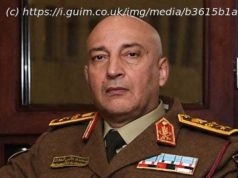The reclusive communist nation has carried out five nuclear tests.
The United States and North Korea have no formal diplomatic relations. The White House appears to be losing patience with softer efforts aimed at persuading the nation to abandon its nuclear weapons program.
Here are some of the flashpoints between Washington and Pyongyang.
Aug. 29: North Korea fired a missile that traveled over Japan and landed in the Pacific Ocean. U. S. officials identified it as a Hwasong-12 intermediate range missile that flew 1,667 miles horizontally and about 310 miles at its top altitude. President Trump condemned the launch and warned that “all options are on the table” for dealing with North Korea.
Aug. 26: North Korea fired three short-range missiles into the Sea of Japan. Two failed in flight while one blew up almost immediately after launch.
Aug. 9: Hours after President Trump’s threat of “fire and fury, ” North Korea announces that its military is “examining the operational plan” to strike areas around Guam, a U. S. territory with 160,000 residents and a key military installation.
Aug. 8: Trump threatened to unleash “fire and fury like the world has never seen” on North Korea if it continued to make threats against the United States.
July 28: After launching its first intercontinental ballistic missile (ICBM) three weeks earlier, North Korea fired a second test of its Hwasong-14. It traveled 3,200 miles into space and splashed down about 88 nautical miles from Hokkaido, Japan. Experts said the missile had the capacity to reach the U. S. mainland. Trump blasted China afterward on Twitter: “I am very disappointed in China… they do NOTHING for us with North Korea, just talk. We will no longer allow this to continue. China could easily solve this problem!”
July 4: North Korea launches its first ICBM, the Hwasong-14, also known as the KN-20. It traveled 1,730 miles into the air and splashed down 577 miles away in the sea of Japan. Secretary of State Rex Tillerson called the launch “a new escalation of the threat to the United States, our allies and partners, the region, and the world.”
June: North Korea fired four surface-to-ship cruise missiles into the Sea of Japan.
May: Following the inauguration of new South Korean president Moon Jae-in, North Korea fires medium-range ballistic missiles which travel several hundred miles – far enough to reach U. S. bases in Japan.
April: North Korea conducts tests of its Hwasong-12 ballistic missile. Each of the missiles exploded or traveled only a short distance.
March: Four ballistic missiles fired into Sea of Japan. Three land within 200 miles of Japan’s coastline. There are more than 50,000 U. S. troops stationed in bases across Japan.
February: A medium- to intermediate-range ballistic missile is fired into Sea of Japan. The Pukguksong-2 missile was not previously thought to be part of North Korea’s arsenal of weapons.
January: North Korean leader Kim Jong Un says his country is in the final stages of developing long-range missiles with nuclear warheads. The statement comes less than a month before Donald Trump’s inauguration.
September: The fifth, and possibly biggest, nuclear test is carried out on the anniversary of North Korea’s founding in continued defiance of U. N. sanctions.
September: Three ballistic missiles fired, one of which enters Japan’s air space.
August: Ballistic missile fired from submarine crashes into Sea of Japan.
February: Long-range rocket puts satellite into orbit. The U. S. says the satellite is “tumbling in orbit” and not working properly.
January: Experts skeptical over North Korean claims it carried out fourth nuclear test, of a hydrogen bomb. New United Nations sanctions prepared.
September: North Korea threatens a nuclear attack against the U. S. Washington calls on Pyongyang to fulfill international peace obligations.
July: Missile tests conducted ahead of Chinese president’s visit to South Korea.
March: Two ballistic missiles tested over the Pacific Ocean, the first such tests since 2009, violating a U. N. resolution. The launches occur on the fourth anniversary of the sinking of a South Korean warship by the North.
February: New U. N. sanctions after third nuclear test staged, the first under new leader Kim Jong Un. North Korea claims it tested a “miniaturized” nuclear device that security experts fear is harder to detect. No independent confirmation.
April: Test of long-range rocket capable of hitting U. S. fails.
May: Second nuclear test, also underground, prompts angry response from world governments.
April: Long-range rocket test. North Korea hails it as a success. The U. S. says it failed and fell into the sea.
October: First nuclear test conducted at an underground facility. U. N. imposes broad array of sanctions.
July: Seven missiles with capability of hitting long-range targets in the U. S. tested.
February: North Korea admits it has produced nuclear weapons that it says are for self defense and says it is not interested in disarmament talks.






